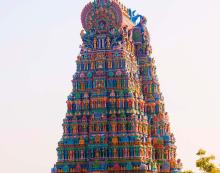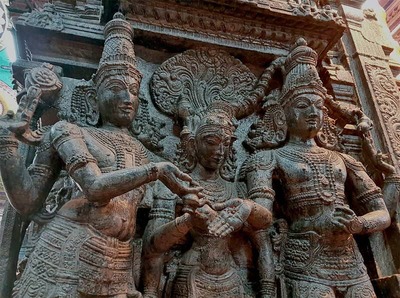
Meenakshi Temple
Meenakshi Temple, also known as Meenakshi Amman Temple or Meenakshi Sundareswarar Temple, is a temple complex located in Madurai, Tamil Nadu state, India. It is believed to have its origins dating back to the 4th century CE, but its current form was constructed during the 16th–17th centuries.
According to Hindu mythology, the god Shiva assumed the form of Sundareswarar and came to Madurai to marry Meenakshi, the daughter of the Pandya ruler. Meenakshi, in turn, was an incarnation of the goddess Parvati. The Meenakshi Amman Temple is a tribute to their divine union.
This temple is renowned for its remarkable architecture and was once nominated as one of the wonders of the world, though it did not make it onto the final list of the 'Seven Wonders of the World.' Nevertheless, it unquestionably stands as one of the 'Wonders of India.'
It is also a major tourist attraction in South India, drawing thousands of devotees every day. During the 'Tirukalyanam Festival,' which spans 10 days, the temple welcomes over a million devotees. Despite the daily influx of visitors, the temple is meticulously maintained and has earned the title of the 'Best Swachh Iconic Place' (cleanest iconic place) in India.
Meenakshi Temple Mythology
According to a legend, the story of Meenakshi begins with her emergence from a sacred fire, known as a 'Yajna,' when she was just a three-year-old girl.
This Yajna was conducted by King Malayadwaja Pandya and his wife, Kanchanamalai, who were childless. Seeking a son, the King prayed to Lord Shiva.
To their astonishment, a girl with three breasts emerged from the ritual fire. Troubled by her unusual appearance, the King and Queen received divine guidance not to be concerned about her physical form.

They were told that the third breast would disappear when she met her future husband. Relieved, the King named her Meenakshi and eventually designated her as his successor.
Meenakshi assumed the throne of the ancient city of Madurai and even expanded her kingdom by conquering neighboring realms.
Legends tell of her ambition to capture Indralok, the celestial abode of Lord Indra, and her journey toward Kailash, the divine abode of Lord Shiva.
It was during her encounter with Shiva that her third breast vanished, signifying her union with her destined partner. Meenakshi and Shiva returned to Madurai, where they were wed.
This grand wedding ceremony was said to be attended by numerous gods and goddesses. As Parvati herself had incarnated as Meenakshi, Lord Vishnu, Parvati's brother, entrusted her to Lord Shiva.
This wedding is commemorated annually as 'Chithirai Thiruvizha,' also known as 'Tirukalyanam' (the grand wedding).
Meenakshi Temple History
The history of the Meenakshi Temple can be traced back to the 1st century C.E., with some scholars asserting that its origins are as ancient as the city itself.
According to legend, King Kulashekarar Pandyan, who ruled the Pandyan dynasty, constructed the temple based on instructions he received in a dream from Lord Shiva.
Several religious texts dating from the 1st to the 4th century C.E. mention the temple, describing it as the central structure of the city. Texts from the early 6th century refer to the temple as a gathering place for scholars to engage in important discussions.
However, the temple in its current form underwent reconstruction during the 16th century due to destruction by Muslim invaders.
In the 14th century C.E., Malik Kafur, a commander of the Delhi Sultanate, led his army through much of southern India and plundered several temples, including the renowned Meenakshi Temple.
Precious valuables like gold, silver, and gems were looted and transported to Delhi. Since temples during that era possessed considerable wealth, many of them were ravaged and left in ruins.
When the Vijayanagar Empire gained control of Madurai after defeating the Muslim Sultanate, the temple was reconstructed and reopened.
Further expansion of the temple occurred in the late 16th and early 17th centuries under the rule of Vishwanatha Nayakar, a monarch from the Nayaka dynasty.
Researchers suggest that during the temple's reconstruction, the Nayaka dynasty rulers adhered to the architectural principles outlined in the ancient texts known as 'Silpa Shastras.'
Meenakshi Temple Architecture
Renowned as one of South India's largest temples, the Minakshi-Sundareshwarar Temple boasts breathtaking architecture adorned with captivating murals.
- The temple features an impressive array of gopurams, including 4 Raja gopurams, 2 gold gopurams, 1 Chithirai gopuram, 5 five-floored gopurams, and 2 three-floored gopurams, all of which command majestic appearances.
- One of its most renowned attributes is a hall containing a thousand pillars, a sacred pool graced by a golden lotus for ritual baths, a wedding hall, numerous small shrines, lush gardens, and shelters for elephants.
- Remarkably well-preserved, the temple earned the distinction of being named the 'Best Swachh Iconic Place' in India in 2017 by the Central Government.
Best Time to Visit Meenakshi Temple
October to March is the best time to visit Meenakshi Temple.
☀️Summer (March to May)
Madurai experiences its summer season from March to May, with temperatures ranging from 24 degrees Celsius to 34 degrees Celsius. During these months, the weather in Madurai becomes notably hot, accompanied by dry conditions that intensify the heat, often dissuading travelers from visiting. Consequently, the summer season is considered an off-peak period for Madurai, leading to fewer crowds.
⛈️Monsoon (June to August)
The monsoon season in Madurai spans from June to August. While this monsoon period is relatively short, it is characterized by the arrival of heavy rainfall brought in by the south-west monsoon winds. This abundant rainfall, although it can make the weather overcast, lends a striking beauty to the city, particularly benefiting the surrounding natural landscapes. For those who appreciate lush greenery and the vibrant natural environment, this is an ideal time to visit Madurai.
❄️Winter (December to February)
The winter season in Madurai is eagerly anticipated by many locals as it offers respite from the scorching summers. This season spans from December to February, with temperatures ranging from 20 degrees Celsius to 29 degrees Celsius.
During this time, the city enjoys moderately cool weather, creating a pleasant environment for travelers. Madurai holds Pongal, a widely celebrated festival, in high regard.
This three-day festival involves prayers for a bountiful harvest and is cherished by both locals and farmers. Additionally, various religious festivals are celebrated with great enthusiasm. However, it's worth noting that hotel prices tend to rise during this peak tourist season.
Official website - http://www.maduraimeenakshi.org/
How To Reach
✈️ By Air
Madurai Airport (Airport code IXM) is the nearest airport and Meenakshi temple is almost 12-13 km.
Checkout - https://maps.app.goo.gl/G6JQ4PCbL7PXCLBj6
🚝 By Train
The closest railway station is Madurai Junction, and the Meenakshi temple is just a 10-minute journey from there. To reach the Madurai Meenakshi temple, you can either take a taxi or opt for an autorickshaw.
🚗 By Road
If you are traveling to Madurai by road using a state or private bus to visit the temple, you can disembark at the Mattuthavani Bus Stand. From there, it's just a 20-minute journey to reach the Meenakshi Sundareshwara Temple.
Meenakshi temple Opening Timings
The Madurai Meenakshi temple opens its doors for darshan from 5 AM to 12.30 PM and reopens again at 4 PM, remaining accessible until 9.30 PM.
When planning a visit to the Meenakshi Temple, it's advisable to allocate at least two to three hours for a leisurely exploration of the temple and to have darshan of the deity.
During festivals, the darshan time may extend to approximately 4 to 5 hours.
Question: What is so special about Meenakshi Temple?
Answer: The Meenakshi Amman Temple, alternatively called the Minakshi-Sundareshwara Temple, stands as one of India's oldest and most significant temples, celebrated for its remarkable Dravidian architectural style. Situated within the city of Madurai, Tamil Nadu, this temple carries profound mythological and historical importance.
Question: Which God is in Meenakshi Temple?
Answer: The temple is devoted to the Goddess Meenakshi, who represents a manifestation of Shakti, and her partner, Sundareshwarar, representing a form of God Shiva.
Question: What is the story of the goddess Meenakshi Temple?
Answer: The legend narrates the story of King Malayadhvaja, a Pandya king, who ardently desired a son and heir. To attain this wish, he meticulously conducted a sacred fire ceremony, beseeching the gods for a male offspring. However, the gods granted him a daughter named Meenakshi, who was born with an unusual feature - three breasts.
Question: How long does it take for darshan in Meenakshi Temple?
Answer: When planning a visit to the Meenakshi Temple, it's advisable to allocate at least two to three hours for a leisurely exploration of the temple and to have darshan of the deity. During festivals, the darshan time may extend to approximately 4 to 5 hours.
Question: What is not allowed in Meenakshi Temple?
Answer: Camera is not allowed.
Question: Is Meenakshi Temple a seven wonders of the world?
Answer: This temple is renowned for its remarkable architecture and was once nominated as one of the wonders of the world, though it did not make it onto the final list of the 'Seven Wonders of the World.' Nevertheless, it unquestionably stands as one of the 'Wonders of India.'
Question: Did Lord Shiva marry Meenakshi?
Answer: Yes. Sundareshwarar, representing a form of Lord Shiva.
Question: What are the secrets of Meenakshi Amman temple?
Answer: The idol of Meenakshi is portrayed with three breasts, symbolizing her birth with this unique feature and the blessing that the third breast would disappear upon meeting her destined life partner. It is believed that the third breast indeed vanished when she encountered Lord Sundareswarar, a manifestation of Lord Shiva.
Question: Are Non-Hindu / Muslims allowed in Madurai Meenakshi Temple?
Answer: Non-Hindu visitors are allowed entry into the temple, but access to the main Shrines of Sundareswarar and Meenakshi Amman may be restricted. Nevertheless, they are welcome to appreciate the depicted sculptures, explore the 1000 Pillars hall, and visit the various shops within the temple premises. Contact Temple Adminstration for more info.
Question: Is jeans allowed in Meenakshi Amman Temple?
Answer: Formally, there is no specified dress code enforced at the Meenakshi Amman Temple. However, out of respect for tradition, visitors are encouraged to don traditional Indian attire. Consequently, it is recommended for women to wear sarees or salwar-kurti-dupattas, while men are advised to wear kurtas or shirts with dhotis or pyjamas.

